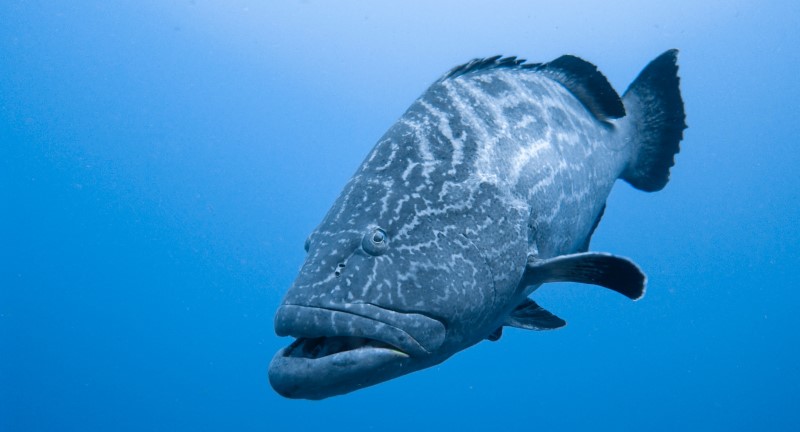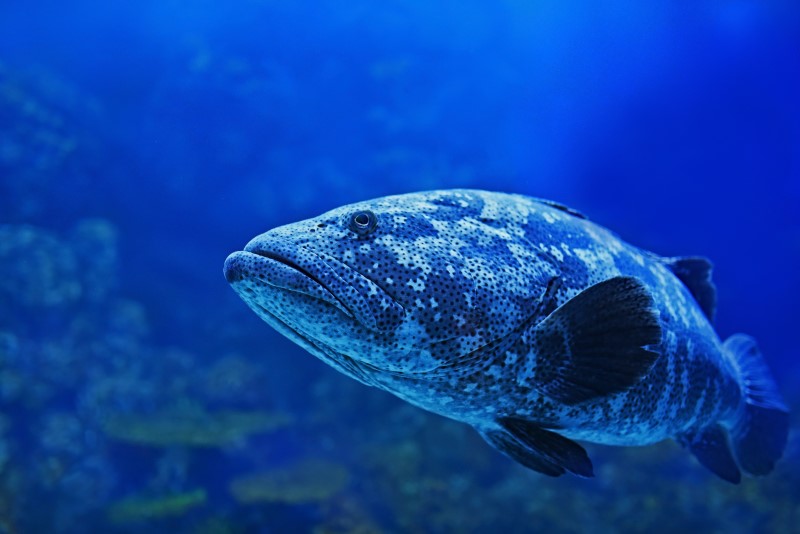Whether scuba diving, freediving, snorkeling or spearfishing, you can’t help but be amazed by the variety of life you encounter beneath the waves. It’s one of the many attractions of engaging in these pastimes – sharing the environment with all kinds of sea creatures that dart about their business all around you. Brilliant colors flash by, through coral and kelp. Fish of all shapes and sizes slip past, sometimes wary, other times oblivious to your presence. It’s a real privilege that never gets dull and keeps us heading back to the water time after time. Some species stand out for various reasons – and not always good ones. One fish that is a common hassle to spearos is known as the Goliath Grouper.
Table of Contents
- What Is A Goliath Grouper?
- How Big Are Goliath Grouper?
- Why The Hate In Spearfishing Circles For Goliath Groupers?
- What Do Goliath Grouper Eat?
- Where Can You Find Goliath Groupers?
- Goliath Grouper Nicknames
- Goliath Grouper Facts
- Goliath Grouper Spearfishing
- Are Goliath Grouper A Protected Species?
- Conservation Efforts For The Goliath Grouper
- Final Thoughts
- Frequently Asked Questions
What Is A Goliath Grouper?

Without getting too technical, there are many different species that fall under this category – 234, to be precise. Basically, a grouper is a large, slow-moving saltwater fish that doesn’t travel too far if it doesn’t have to, as they just aren’t built for it. The longest journeys it will take are from the ‘nursery’ to its chosen habitat and during spawning season.
Though species vary widely, most will have a ‘tooth-plate’ for crushing, using the sharp teeth to prevent prey from escaping rather than biting or chewing. So, instead of taking chunks out of their prey, they effectively vacuum them up by sucking them into their huge mouths and swallowing them whole using ‘negative pressure’. This is a fact that some divers and underwater hunters can attest to, having been unlucky enough to get too close! There are no confirmed cases of them being fatal to humans, though reliable reports of them swallowing sharks have been recorded.
- Although groupers of different types are present all around the world, our friend, the Goliath Grouper, is usually found in shallow tropical waters, mostly around coral (or artificial) reefs.
- They lurk in wrecks and potholes or hang around the ledges where spearos love to hunt.
- Although they’re not regarded as being a danger to humans, you should always be wary when there’s a ‘group of groupers’ hanging about.
- Often, you’ll hear them before the massive shadow looms overhead, obscuring the sunlight and blocking your route to the surface. They emit a strange rumbling sound using their swim bladder that warns you of their approach.
How Big Are Goliath Grouper?
The Goliath Grouper can reach a length of up to 8ft, with some specimens reaching 10ft in length. Typically, they weigh around 400 lbs, although heavier specimens have been recorded.
Their size is one of the main reasons why they are so well known in the sport of spearfishing.
Their large bodies and slow movements make them easy targets for skilled shooters. However, being able to hit such a huge fish is an altogether different challenge! Whilst you don’t need to worry about being eaten by a Goliath Grouper, you should still keep your distance and respect this magnificent species.
Goliath Groupers are ‘ambush feeders’, using stealth and strategy to catch their prey rather than strength or speed. With a sudden snap of their immensely powerful jaws, they suck in and crush their prey, usually smaller fish, crustaceans, or octopuses. They generally amble about, minding their own business, only gathering with others when it’s time to reproduce. It’s a good idea to keep out of the way as you don’t want to get caught between these giants, however gentle they seem.
Why The Hate In Spearfishing Circles For Goliath Groupers?
Some veteran divers, anglers, and spearfishermen have a different opinion; these fish are mean, selfish bullies! The blue seas have frequently become bluer from the curses uttered by enraged underwater hunters who have had their hard-earned catch snatched away at the last minute. From a naturalist’s point of view, it makes sense. It conserves energy – the prey is right in front of them, so why not? They don’t understand that you’ve been fishing for hours without a bite, or you’ve been diving for hours and were just about to bring your prized catch to the surface. But this is of little comfort when you’re there in the water and some lumbering great fish has ruined your day.
What Do Goliath Grouper Eat?
Groupers, in general, will feed on a wide range of prey – including crustaceans, mollusks, and other fish. As they get bigger, they move onto larger prey such as octopuses and moray eels. Some specimens have even been known to attempt to challenge their predators by crunching up sharks with their powerful jaws.
Can A Goliath Grouper Eat A Shark?
Yes, it’s true. Goliath Groupers have been known to eat sharks! The grouper has an immensely powerful jaw and is capable of drawing small sharks and rays into their huge mouths and swallowing them whole using ‘negative pressure’. They do this by swimming up to the sharks and using their gill covers and mouths to try and funnel them in, effectively vacuuming them up by sucking them into their huge mouths and swallowing them whole. This is a fact that some divers and underwater hunters can attest to, having been unlucky enough to get too close!
Where Can You Find Goliath Groupers?
Goliath Groupers are found in the warm waters of the western Atlantic. They inhabit coral reefs, rock ledges, and shipwrecks. They can also be found in estuaries and other shallow inshore areas.
Goliath Grouper Nicknames

These fish are so beloved that some divers and spearfishermen have given them nicknames such as ‘Juggernauts’, ‘Garbage Trucks’ or even the ‘Grouper Taxi’. It’s worth noting that Goliath Groupers can be quite gentle, almost like a big puppy dog. The name Goliath Grouper is a relatively recent one. Before this, other names by which they have been known include the following:
- Giant Seabass
- Blackbass
- Esonue Grouper
- Hamlet
- Jewfish
- Camapu or badejo (Portuguese)
- Cernia Gigante or sciarrano (Italian)
- Guasa or cherna (Spanish)
- Merou (French)
- Zackenbarsch (German)
History Of The Goliath Grouper Name
Until recently, they were mostly known in the English language as Jewfish. The reasons for this name, which has been around for at least 300 years, are unclear. And this uncertainty has added to the calls for the sudden change. There have been a few complaints that the name was ‘culturally insensitive. Therefore, the American Fisheries Society ordered a gathering of their Committee on Names of Fishes to discuss changing the name.
The name Jewfish, however, may have originally been entirely innocent of any hints of anti-semitism. Some people believe it to be a corruption of ‘jawfish’, or even relates to the Italian giupesce, meaning ‘bottom-fish’. Others claim that it is because the flesh from these fish had a clean taste, like ‘kosher’ food. However, there are less tasteful interpretations that refer back to the dark days of Jewish persecution. They say that the fish was an inferior food and therefore only suitable for Jews.
In these (hopefully) more enlightened times, we can see the problem with this. A lot of divers and spearfishers continue to call them Jewfish as some habits are hard to break. Some will use this old name because of the tendency of the Goliath Grouper to steal prey from their lines. While this may make some people flinch in our age of political correctness, you can be pretty sure that there is no malice involved.
Goliath Grouper Facts
Now that we have the name sorted out, here are some interesting facts about Goliath Groupers:
- They can grow to an impressive 8 feet (2.5 meters) long and weigh in at a whopping 400+ lbs (360 kilograms).
- The world record goliath grouper was caught in 1961 off Fernandina Beach, Florida and weighed an astounding 680 lbs (308 kilograms).
- They can be identified – other than by size – by the large mouth, yellow/brown mottling with black spots, and their rounded snout and tail.
- They also have five distinguishing dark bands across the body, which is more visible in the younger fish.
- When young, they spend between 5 and 6 years in the mangrove swamps, particularly the Ten Thousand Island area of southwest Florida. The mangroves are a critical ‘nursery habitat’ for these fish, essential for population recovery and continuity.
- Once they reach maturity, they swim out to find areas with shallow reefs, piers, bridges, and wrecks.
- When it is time to reproduce, between July and September, they gather in groups to engage in ‘broadcast spawning’, where the females release millions of eggs and the males release sperm (called milt) into the ocean currents. The eggs hatch in the ocean and make their way to the mangrove estuaries where they thrive and grow, forming the next generation, and so the cycle continues.
- They are believed to be protogynous hermaphrodites – that is, they are all born female but certain individuals transition into males at some stage in their life cycle. Although the case for some species of Grouper, this hasn’t been proven in Goliaths.
Goliath Grouper Spearfishing
Spearfishing for these giant fish can be a thrilling experience, but be sure to know the regulations. In the US, goliaths are protected and it is illegal to catch or keep them. It is also illegal in many other countries around the world due to its slow maturation rate and overfishing.
Goliath Groupers may be imposing creatures, but they are still vulnerable to overfishing and other human pressures. It is the responsibility of the spearfishing community to help protect these gentle giants. Therefore, future generations can enjoy the thrill of seeing them.
Be sure to check with your local laws and regulations before even thinking of spearfishing for goliath groupers.
Are Goliath Grouper A Protected Species?
The Goliath Grouper has always presented itself as an easy target. Its sheer size made it an attractive prey, and when coupled with the fact that it moves slowly, is inquisitive by nature, and tastes good, you have a recipe for extinction. Overfishing has reduced this species by 80%.
They are predictable in their movement, which made them easy to find and catch. Spearfishers knew they could find them in shipwrecks and reefs. In addition, they gather in groups of 100 or more at spawning grounds. Unsustainable numbers of fish were taken without much thought for the future of the species.
In addition to improved equipment and hunting techniques used by undersea hunters, massive development along the mangrove coasts threatened their juvenile habitat. Stocks grew so low that the species reached ‘commercial extinction’ in the late 1980s. At that time, it was considered for listing under the Endangered Species Act.
Ban On Killing Goliath Groupers
In 1990 a federal and state ban on killing Goliath Groupers was introduced in Florida, Mississippi, Alabama, Texas, and Louisiana. And in 1993 this was extended to the US Caribbean. They are also listed as ‘vulnerable’ on the IUCN (International Union for Conservation of Nature) Red List.
Thirty years or so on, stocks are recovering, but are still nowhere near where they were prior to overfishing. This is partly because they are slow-growing and take many years to reach sexual maturity. Although the maximum recorded age is 37 years, some scientists believe they could reach 50 or even 100 years of age.
There is an argument that stocks are recovered well enough to allow limited numbers to be hunted again. Those who support this view claim that Goliath Groupers are contributing to species loss on reefs. Contrary to this, studies show that Groupers (and other predators) increase diversity within reef communities, adding to their importance as a species, and therefore strengthening the case for their protection.
Whether scientists, conservationists, divers, or spearfishers, we have a responsibility to protect Goliath Groupers and their habitats for future generations.
Conservation Efforts For The Goliath Grouper
The Goliath grouper is an iconic species in the Gulf of Mexico and along the Atlantic Coast. Despite their size, these gentle giants are still vulnerable to overfishing and other human pressures.
In response, numerous conservation efforts have been implemented to protect them for future generations. These include Marine Protected Areas (MPAs) that restrict fishing, as well as no-take zones that restrict any form of fishing.
In addition, research is being done to understand the current population status and develop a recovery plan for the species. Several researchers are also conducting tag-and-release studies on goliath groupers to help monitor their populations better.
Finally, the goliath grouper spearfishing community is helping to raise awareness about the importance of protecting this species. They are educating others and advocating for responsible fishing practices that help protect these gentle giants.
By taking these steps, we can ensure that goliath groupers remain a part of our ecosystems for years to come.
Final Thoughts
Goliath Groupers are impressive creatures, with remarkable size and power (they can reach up to 8 feet in length and weigh up to 800 pounds!) As such, they should be treated with respect. We must all do our part to protect them from overfishing and other human activities that are contributing to their decline.
By taking the time to learn about the goliath grouper size, habitat, behavior, and life cycle we can help ensure their continued survival. We should also support conservation efforts that aim to protect this species for future generations. Together, we can help ensure that goliath groupers remain a part of our marine ecosystems for years to come.
The future of the Goliath grouper is in our hands. Let’s do what we can to make sure they can thrive for generations to come!
Frequently Asked Questions
Is it legal to spearfish goliath groupers?
It is illegal to spearfish goliath groupers in most areas due to their protected status.
Where do goliath groupers live?
Goliath groupers are usually found in shallow waters near coral reefs, seagrass beds, mangroves and rocky outcroppings. They can be found along the east coast of Florida, the Gulf of Mexico, South America and parts of the Caribbean.
What is being done to protect goliath groupers?
Conservation efforts to protect goliath groupers include Marine Protected Areas (MPAs) that restrict fishing, no-take zones that prevent any form of fishing, and research projects aimed at understanding the current population status. Spearfishers are also helping raise awareness about the importance of protecting these gentle giants by educating others and advocating for responsible fishing practices.
Are goliath groupers endangered?
Goliath groupers are currently listed as “vulnerable” by the IUCN Red List of Threatened Species, meaning they are at risk of becoming endangered in the near future if conservation efforts are not successful. Therefore, it is important to continue protecting these species so they can remain a part of our ecosystems for years to come.





